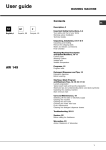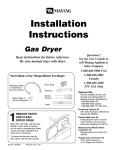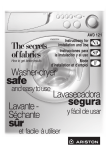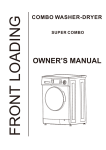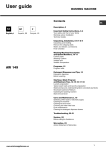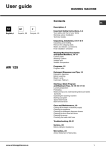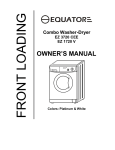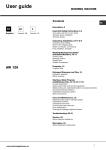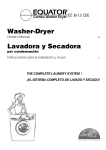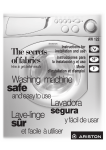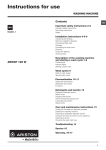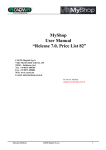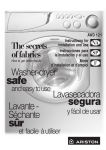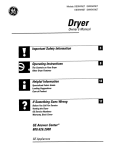Download Ariston AW 125 User guide
Transcript
User guide WASHING MACHINE Contents NA English,1 SP Español, # F Français, 49 NA Description, 2 Important Safety Instructions, 3-4 Your safety and that of your family Warnings about installation Technical details Unpacking, Installation, 5-6-7-8-9 Unpacking and levelling Remove the shipping bolts Water and Electric connections Final Installation Checklist AW 125 Washing Machine Description and Option Modifiers, 10-11 Control panel Washing Options Variable spin Variable temperature Programs, 12 Program table Detergent Dispenser and Tips, 13 Detergent dispenser Before washing Bleach cycle Cashmere Platinum Starting a Wash Program and Washcare Tips, 14-15-16-17-18 Laundry preparation Pretreating Washcare tips and understanding fabriccare labels (symbols) Operating the washing machine Starting a program Typical wash loads Stain removal chart Care and Maintenance, 19 Cutting off the water or electricity supply Cleaning the appliance Cleaning the detergent dispenser drawer Cleaning the door bowl and drum Cleaning the pump Checking the water inlet hose Troubleshooting, 20-21 Service, 22 Before calling for Assistance Warranties, 23 Ariston Statement of Warranties www.aristonappliances.us 1 Description NA Program listing Dispenser drawer Control panel, pages 10-11 ( Varies by Model) Please record the Model number and Serial number of your machine located behind the door for future reference. Interlocking door and release lever Front adjustable feet Power cord Hot and Cold water inlet points Four shipping bolts ! They must be removed BEFORE you use your machine (see page 6) ! The machine was designed and built in compliance with the appliance international safety regulations. The following information is provided for your safety and should consequently be read carefully. 2 Drainage hose Back feet www.aristonappliances.us Important Safety Instructions INTRODUCTION Congratulations on your new Ariston washing machine. This is a highly sophisticated engineered product that will give you many years of satisfaction. Please spend a few moments reading the Owner Manual. This will show you ways to best utilize your valuable purchase Save these instructions Your washing machine has been built in compliance with the strictest international safety regulations, to protect you and all your family. WARNING To reduce the risk of fire, electrical shock, or injury to persons when using your appliance, follow basic precautions, including the following: 1. Read all instructions before using the appliance. 2. Install and level the clothes washer on a floor that can support the weight. 3. This appliance must be properly grounded. Never plug the appliance cord into a receptable which is not grounded adequately and in accordance with local and national codes. See installation instructions for grounding this appliance. 4. To avoid the possibility of fire or explosion: - Do not wash articles that have been previously cleaned in, washed in, soaked in, or spotted with gasoline, dry cleaning solvents, other flammable, or exlosive substances as they give off vapors that could ignite or explode. - Do not add gasoline, dry cleaning solvents, or other flammable or explosive substances to the wash water. These substances give off vapors that could ignite or explode. - Under certain conditions hydrogen gas may be produced in a hot water system that has not been used for 2 weeks or more. HYDROGEN GAS IS EXPLOSIVE. If the hot water system has not been used for such a period, before using a washing machine, turn on all hot water faucets and let the water flow from each for several minutes. This will release any accumulated hydrogen gas. As the gas is flammable do not smoke or use an open flame during this time. - To reduce the risk of fire, clothes, cleaning rags, mop heads and the like which have traces of any flammable substances, such as vegetable oil, petroleum based oils or distillates, waxes, fats, etc. must not be placed in the washing machine. These items may contain some flammable substances after laundering, which may smoke or catch fire by itself. 5. Always be sure to unplug the washing machine from the electrical supply before attempting any service. 6. Do not insert/pull out the mains plug with wet hands. www.aristonappliances.us 7. Do not pull out the mains plug by tugging the cable. To reduce the risk of fire or electrical shock, DO NOT use an extension cord or an adapter to connect the washing machine to the electrical power supply. 8. Caution when draining hot water. 9. The washing machine must only be used for its intended purpose. 10. Make sure that all water connections to the washing machine have shut-off valve(s) and that they are readily accessible. Close the washing machine shut-off valve(s) at the end of each wash day. Check the fill hose connections on a regular basis to assure that they are tight and not leaking. 11. Do not allow children to play on or in the appliance. Close supervision of children is necessary when the appliance is used near children. 12. Before the appliance is removed from service or discarded, remove the door. 13. Do not reach into the appliance if the tub or drum is moving. 14. Do not install or store this appliance where it will be exposed to the weather. 15. Do not tamper with controls. 16. Do not repair or replace any part of the appliance or attempt any servicing unless specifically recommended in the user-maintenance instructions or in published user-repair instructions that you understand and have the skills to carry out. 17. Do not use fabric softeners or products to reduce static unless recommended by the manufacturers of the fabric softener product. 18. Do not machine wash fiberglass materials. Small particles can stick to fabrics washed in following loads and cause skin irritation. 19. Inlet hoses are subject to damage and deterioraton over time. Check the hoses periodically for bulges, kinks, cuts, wear or leaks and replace them every five years. 3 NA NA RECESSED, CLOSET AND ALCOVE INSTALLATION (Instructions) Te c h n i c a l d e t a i l s M od el AW 125 D im en sion s 2 3 .4 " (5 9 .5 c m ) 3 3 .4 " (8 5 c m ) 2 0 .8 " (5 3 c m ) C a p a c ity f r o m 2 t o 1 2 L b s (5 K g ) E l e c t ri c c on n ec tion s v o lt a g e 1 2 0 V o lt s 6 0 H z m a x im u m W ater c on n ec tion s m a x im u m p r e s s u r e 1 0 0 p s i (6 8 9 . 6 k P a ) m in im u m p r e s s u r e 2 0 p s i (1 3 7 . 9 k P a ) d r u m c a p a c it y 4 6 lit r e s S p in sp eed u p t o 1 2 0 0 rp m C UL ® US LISTED T h is an d an d an d w id e h ig h d eep a p p lia n c e w a s t e s t e d b y U L c o n f o r m s w it h b o t h C a n a d ia n U . S . U L s a f e t y r e q u ir e m e n t s d is p la y s t h e ir M a r k In d e s it C o m p a n y o f f e r s t o h is c u s t o m e r s p r o d u c t s w it h t h e E N E R G Y S TA R L ab el The machine may be installed in a recessed area, closet or alcove. The installation spacing is in inches and is the minimum acceptable. Additional spacing should be considered for easy installation, servicing and in compliance with local codes or ordinances. Other installation must use the minimum dimensions indicated . Minimum installation spacing * Additional clearances for wall, door and floor moldings maybe required. As a result of technological progress, the manufacturer reserves the right to make any improvements to its appliances without giving prior notice to its clientele. 4 www.aristonappliances.us Unpacking ! Keep this instruction book on hand in order to refer to it when necessary. Take it you when you move, and should you sell this appliance or pass it on to an other party, make sure that this booklet is supplied along with the appliance so that the new owner may be informed about warnings and suggestions on how the works. Unpacking 1. Using scissors, cut carefully along one corner post to remove the film. 2. Open the door, check inside the drum and remove the accessories bags. ! Retain all packaging material until installation is complete. 3. Lift of the polystyrene top cap and remove the 5. Remove the polystyrene base. 6. ! IMPORTANT check when unpacking your machine: ! This is the part of the polystyrene base and should have stayed intact when you removed the base. If it has broken off and is still in the machine remove it while the machine is still laying on its side on the top cap. 7. Stand the machine upright. four corner posts. 4. Carefully lay the left side of the machine down onto the top cap. ! www.aristonappliances.us We reccomend that a second person help to raise and lower the machine. Protect the environment Please dispose of the packaging material carefully and considerately. ! Continue to read the rest of these instructions carefully; the following pages contain important information on installation and troubleshooting. 5 NA NA Remove the Shipping Bolts Location IMPORTANT: Read these instructions to remove the 4 shipping bolts (see Description for location). Situated on one either side of the rear panel, All shipping bolts MUST be removed before use. ! Failure to do so may cause damage to your machine. It is important the transit bolt and spacer (see pic) come out intact. Where you install your machine will affect its performance: ! For your safety and to comply with electrical regulations, seek professional advice if you want to install your machine in a bath or shower room. 1. Unscrew the bolt using a 13 mm wrench. Make sure that the electrical socket and water taps are easily accessible. You should switch off the machine's electrical and water supplies when you are not using it for extended periods. Make sure that you allow enough space for the machine. Select a space at least 23.6 (60 cm) wide, 23.6 (60 cm) deep and 33.4 (85 cm) high. Also leave enough space to open the door fully, so that you can load and unload it easily. Where possible, the machine should be positioned on a solid floor to minimise vibration. Take care when you move the machine not to rip any floor coverings. The weight of the machine may cause indentations in some floor coverings. Levelling 2. STOP when 3 threads can be seen. Your machine will be noisy if the two front feet are not adjusted so that the machine stands firm and level. ! The machine should be levelled from side to side and from front to back. 3. Hold, slide sideways and pull to remove. 4. For safety, close the holes left by removing the bolts. ! Packaging materials are not children's toys. Did you know? 6 1. Move your machine into its final location. - Take care not to trap or kink the hoses. 2. Turn one or both front feet counter-clockwise by hand until the feet cannot be turned any more. When adjusting the feet, use a spirit level to check the machine stands level, from side to side and from front to back. If the floor is not perfectly level, compensate for any unevenness by tightening or loosening the adjustable front feet (see figure); the angle of inclination, measured according to the worktop, must not exceed 2°. The spring on each foot will stop them coming loose. ! If it is placed on a fitted or loose carpet, adjust the feet in such a way as to allow enough room for ventilation beneath the machine. the shipping bolts are fitted to ensure that your machine is undamaged during delivery. ...both of the shipping bolts must be removed before using the machine, not doing so will lead to excessive vibration, movement of the machine and could eventually lead to internal damage. ...the majority of problems with noisy machines are due to the shipping bolts not being removed, closely followed by the feet not being adjusted correctly to level the machine. ...you will be charged for a service engineers visit if a problem with your machine is caused by incorrect installation or misuse. www.aristonappliances.us Installation Water Connection Drainage Connection Caution Standpipe Diameter/Capacity. Needs a 1 1/4 minimum diameter standpipe with a minimum carry-away capacity of 7 gallons per minute. 1. The washing machine must only be operated with cold and hot (max. 140°F//60°C) tap water. Do not connect the appliance to the mixer tap of an unpressured hot-water boiler. NA Top of Standpipe. Must be between 25 - 34 inches (6286 cm) high measured from the bottom of the machine. 2. To prevent water damage, the hot and cold water valves should be accessible when the washer is in place and should always be turned off when the washer is not in use. Outlet End of Drain Hose (provided with the unit). Must be at least 20 above the bottom of the washer. An air break must be available at the standpipe to avoid siphoning. No more than 6 of the drain hose should be inserted into the drain pipe to prevent siphoning. ! Remember: please use the new hoses supplied, fitted to the machine. Old hoses may cause leaks due to worn out washers or may be split due to water pressure. ! Although you may need to move the hooked end support along the grey drainage hose,, DO NOT remove it. Connecting the water inlet hoses Included in the accessories supplied with the machine are 2 inlet hoses. The straight end of these hoses should be connected to the supply. The 90° angled end of these hoses should be connected to the inlet valves on the back of the machine to make a water tight seal on each connection (see below figure). The couplings should be tightened by hand, a tool should only be used if a leak occurs. Do not use excessive force. ! Whichever draining method you use, make sure that the hooked end support is fixed level to, or above the Plumbing Indicator Line. You should carefully position the drain hose to avoid kinks and ensure proper drainage of the water. The outlet end of the drain hose must be at least 25 (62 cm) above the base machine. At this point it s possible for the water to be discharged into a sink or drain pipe, but an air break must be available at this 24 height to prevent the machine from syphoning (see figures page 8). No more than 6 of the drain hose should be inserted in the drain pipe. Repair or replacement of a part should be made only by a qualified service technician to prevent personal injury or damage to the machine. Inlet valves are color coded: Red = Hot / White = Cold Important. Make sure that the drain hose is not kinked and the water flow has not been restricted. The machine must rest solid on a sturdy floor for optimum performance and minimum vibration. Connection. Hints and tips H C 1. Screw the cold water fill hose (C blue connector) onto the cold water supply until tight. 2. Turn on the cold water supply and check for leaks, tighten if necessary. 3. Screw the hot water fill hose (H red connector) onto the hot water supply until tight. 4. Turn on the hot water supply and check for leaks, tighten if necessary. www.aristonappliances.us ! Make sure there are no kinks or bends in the hose. ! The water pressure at the supply tap must be within the values indicated in the Technical details table (see table on page 4). Always use a new inlet hose. Check the water inlet hose at least once a year, replace if cracked as worn hoses could split under water pressure. Do not overtighten. The couplings should be tightened by hand; a tool should only be used if a leak occurs. Do not use excessive force. 7 Installation NA Floor Standpipe Drain Sink Drainpipe Method Top of standpipe must be at least 25 inches (62 cm) high and no higher than 34 inches (86 cm) from the bottom of the washer (A). (A) 25"-34" inches 62 - 86 cm Entry into the sink drain system must be above the trap (see fig. aside ). When routing the drain hose through cabinets or walls use aprotective material such as electrical duct tape to cover sharp edges that could damage the drain hose. Use a suitable clamp to secure the drain hose to the Y branch or the disposer. With a sink drainpipe system (see figures aside and below), you may connect directly: 1) to a disposer by following the manufacturers attachement method. 2) directly to a Y branch tail piece (Available at most hardware stores). 3) through the floor to a separate trap. The trap must be vented to prevent siphoning. To provide proper venting , install an Air Gap Kit (available at most hardware stores). 4) To the faucet using a Faucet Adapter Kit (available separately). It will supply water from your faucet and discharge water directly into your sink drain. 25” 34” Wall Standpipe Drain Under Sink Method Top of standpipe must be at least 25 inches (62 cm) min.; 34 inches (86 cm) max from end of drain hose to bottom of washer (B) (See figures aside and below). 1. Cut the blocked end of the under sink drainage unit. 2. Fix the hooked end supporta minimum of 620 mm from the floor. #^ Hose clamp 620 mm 8 3. Use a hose clip clamp to securely attach the grey drainage hose end to the under sink drainage unit using a hose. clamp www.aristonappliances.us Electrical connection Final installation checklist Machine Voltage/Amperage - 120V, 60 Hz, 3 Amp. Connection - 3-prong plug with 6 cord is provided with the machine. Circuit/Protector - 3-wire single phase, 120V, 60 Hz, AC, on a separate 15 Amp circuit. Instructions and Installalion Kit have been removed from the tub. GROUNDING INSTRUCTIONS This appliance must be grounded. In the event of malfunction, or beakdown, grounding will reduce the risk of electric shock by providing a path for electric current. This appliance is equipped with a cord having an equipment grounding conductor and grounding plug. Plug into an appropriate outlet that is properly installed and grounded in accordance with all local codes and ordances. DO NOT modify the plug provided with the applliance. If it will not fit the outlet, have a proper outlet installed by a qualified electrician. WARNING: Improper connection of the equipment-grounding conductor can result in a risk of electric shock. Check with a qualified electrician or serviceman if you are in doubt as to whether the appliance is properly grounded. Attention ! For your own protection and to prevent accidents, injury and fire, please read the following carefully before installing the washer. Installation and grounding must be done in accordance with local codes and by a qualified installer. Instalation instructions provided in this booklet are for the installers reference. NA Shipping straps have been removed. Washer is plugged into electrical outlet and is properly grounded. Water hoses are connected to the faucets with inlet screens and washers Water is turned on and checked for leaks at faucet and water valve connections. Drain hose is properly located into drain facility and is not collapsed or damaged. Washer has been leveled. Test for proper operation by running the washer through a complete cycle at max temperature. Shipping bolts removed. Washer MUST be installed on a strong, level floor and in a protected dry and well-ventilated area close to a power supply and drain outlet of sufficient capacity. DO NOT install on carpet. Important : Installation on carpet floors will cause the machine to vibrate and may result in excessive machine vibration during the spin cycles and loss of performance. The washer should be plugged into a properly grounded (3) prong electrical outlet capable of 120 Volt, 60 Hz, and 3 Amp. It shouldnt be controlled by a wall switch or pull cord which could be turned off accidentally. For your safety, the third or round grounding prong must never be removed. DO NOT USE AN EXTENSION CORD. DO NOT install or store this appliance where it will be exposed to weather or in an area where gasoline or other flammables are stored. www.aristonappliances.us 9 Washing machine description NA Control panel AW 125 (NA) Warning: To reduce the risk of fire, electric shock, or injury, read the IMPORTANT SAFETY INSTRUCTIONS, (see page 3) before operating this appliance. OPTION Buttons Program listing Detergent dispenser STATUS INDICATOR ON-OFF Button Lights ON-OFF/DOOR LOCK Light START/ CANCEL VARIABLE SPIN SPEED Dial Button VARIABLE TEMPERATURE PROGRAM Selector dial Dial Control panel features Program Listing: To consult a straightforward chart of the different programs available. Program Selector Dial: to select the wash programs. The knob stays still during the cycle. Option Buttons: To select the options available (see Program Table and Option Modifiers). Status Indicator Lights: Show if the door is locked (when lit, the door cannot be opened) and the stage of the program that the machine has reached (wash, rinse or spin). Variable Temperature Dial: To modify the temperature according the chosen programs *. Variable Spin Speed Dial: To reduce the spin speed or exclude the spin cycle completely. On/Off Button: To turn the washing machine on and off. Start/Cancel Button: To start the program or to cancel it, if incorrect settings were selected. 10 ON-OFF/DOOR LOCK led: If this LED is on, the appliance door is locked to prevent it from being opened accidentally; to avoid any damages, wait for the LED to flash before you open the appliance door. ! The rapid flashing of the ON-OFF/DOOR LOCK Led together with the flashing of at least one other LED indicates there is an abnormality. See page 20-21, and in case Call for Technical Assistance. www.aristonappliances.us Program and Option Modifiers Option modifiers NA Superwash: Use this option to select a more intensive wash and time program for the cotton (Heavy cotton, Regular cotton) and syntheticspermanent press (Heavy synthetics, Regular Synthetics). Pre-wash Button: For heavily soiled loads, push this button to add an extra wash to any wash program (except 3-4-7-10-11 programs). Easy Iron Button (Rinse Hold): This option reduces the amount of creasing on fabrics, making them easier to iron. Selecting this option the washing machine will reduce wash action and spin speed (max 600 rpm) for programs 5-6-7 and the machine will stop on the last rinse. For the Silk program, the Soaking (stop with water) is carried out if the button Easy iron is pressed: the washer will pause the cycle in the final rinse with laundry soaking in water. The machine will stay in this state until the Start/Cancel button is pressed again. Extra Rinse: Additional rinse Increases the efficiency of the rinse (except programs 8-9-10-11). Note: This function will carry out a full extra rinse to ensure maximum possible detergent removal. Particularly useful for people with sensitive skin. Variable Spin Speed Dial: Use this option to reduce the spin speed below the maximum for the program you have chosen. Note: The washing machine will automatically prevent you from selecting a spin speed higher than the maximum speed for each program. Variable Temperature Dial*.: Use this knob to set your wash water temperature. Choose between COLD, WARM, HOT, AUTO or variations between. *.Note: When you set the Dial on Auto the washing machine will load water either hot, warm or cold according to the the chosen program, and anyhow at the higher level (of temperature) of the program. Warning: Whether you select an option unsuitable to the chosen program the corresponding LED will blink for some seconds and then will go out. Instead, if the the chosen option is suitable to the chosen program the button LED will stay on. www.aristonappliances.us 11 Program and Options Modifiers AW 125 (NA) NA Type of fabric and degree of soil Program Program Dial N. Max Load Lbs Pre-wash Detergent Fabric Temperature Bleaching (Option) for wash softener F°/C° Options Length of the cycle (min.) without Options Description of wash cycle COTTON HEAVY DUTY Exceptionally soiled whites Heavy K K K 140 / 60 (sheets, tablecloths, etc.) Regular K K K 140 / 60 Regular (Normally soiled whites and fast colors) Light K K 140 / 60 K K (sheets, tablecloths, etc.) Very Soiled whites Stained soiled whites and fast colors (shirts, jumpers, etc.) Cotton+ Bleach Traditional 140 / 60 K Rinse cycles Super Wash Pre-Wash Extra Rinse Super Wash Pre-Wash Extra Rinse Extra Rinse Extra Rinse 80 Wash cycle, two rinse cycles, intermediate and final spin cycles 72 Wash cycle, two rinse cycles, intermediate and final spin cycles 55 Wash cycle, two rinse cycles, intermediate and final spin cycles 85 Wash cycle, three rinse cycles, intermediate and final spin cycles Rinse cycles, intermediate and final spin cycles Extra Rinse Spin cycle Draining and final spin cycle PERMANENT PRESS Heavily soiled fast color synthetics (baby linen, etc.) Heavy Delicate color synthetics (all types of soiled garments) Regular K K Delicate color synthetics (all types of slightly soiled garments) Delicate (lingerie, etc.) K K Light Delicate K K K K K K K 140 / 60 Super Wash Pre-Wash Extra Rinse Easy Iron 140 / 60 Super Wash Pre-Wash Extra Rinse Easy Iron spin cycle Easy iron (*) Wash cycle, two rinse cycles, delicate 59 spin cycle Easy iron (*) Wash cycle , two rinse cycles and 140 / 60 104 / 40 K Rinse cycles Wash cycle, two rinse cycles, delicate 65 Extra Rinse Easy Iron 53 Pre-Wash 60 delicate spin cycle Easy iron (*) Delicates, two rinse cycles, delicate spn Rinse cycles, delicate spin cycle Extra Rinse Spin cycle Draining and delicate spin cycle DELICATES Silk, particularly delicate garments and fabrics Silk K K K Wash cycle, three rinse cycles, 86 / 30 Pre-Wash 39 Draining (curtains, silk, viscose, etc.) Wool Wool Daily - Delicate colors (all types of slightly soiled garments) Daily Wash 30° K K 104 / 40 52 K K 86 / 30 30 (*) Wash cycle, four rinse cycles and delicate spin cycle (600 rpm) Wash cycle, two rinse cycles and delicate spin cycle Special Programs Rinse K Rinse cycles and spin cycle Delicate rinse cycle K Rinse cycles, anti-crease or draining Spin cycle Delicate spin cycle Draining Draining and heavy duty spin cycle Draining and delicate spin cycle Draining (*) For finishing the program press the button start. Important: To cancel the wash program you have just press start button for at leat 5 seconds. 12 www.aristonappliances.us Detergents tips and laundry Detergent dispenser Good washing results also depend on the correct dose of detergent: adding too much detergent won't necessarily make for a more efficient wash, and may in fact cause build up on the interior of your appliance and even pollute the environment. MAX Open up the detergent dispenser and pour in the detergent and fabric softener, as follows. 4 1 2 3 compartment 1: Detergent for pre-wash (powder) Before pouring in the detergent, make sure that extra compartment 4 has been removed. compartment 2: Detergent for the wash cycle (powder or liquid) Liquid detergent should only be poured in immediately prior to the wash cycle start. compartment 3: Additives (fabric softeners, etc.) NA Cashmere Platinum As gentle as a hand wash. Ariston is the only washing machine to have obtained the prestigious Woolmark Platinum Care mark of recognition (M.0303) from The Woolmark Company, which certifies the machine washing of all woollen garments, even those whose label states "hand wash only" . The "Wool" program therefore offers you complete peace of mind when washing all woollen garments, with great performance guaranteed every time. Warning AVOID RISK OF POISONING KEEPING DETERGENTS AND ADDITIVES OUT OF THE REACH OF CHILDREN ! The fabric softener should not overflow from the grid. extra compartment 4: Bleach ! Do not use Hand Wash Detergent because it may form too much foam. Bleach cycle ! Traditional bleach should be used on sturdy white fabrics. MAX Place extra compartment 4, provided, into compartment 1. When pouring in the bleach, be careful not to exceed the "max" level indicated on the central pivot (see figure). MAX The use of extra compartment 4 excludes the possibility of using the pre-wash cycle. www.aristonappliances.us 13 Starting a wash Program NA Laundry preparation Sorting Clothes should be sorted from separate items which could damage other garments. Sort items into loads according to similar colors, fabrics, garment construction and degrees of soil. Color Separate clothes into three groups: Whites and pastels, medium and bright colors, Dark colors. Items which bleed color should be washed alone. Type of fabrics Delicate items should be separated from sturdier items. Fabrics that shed lint should be separated from the ones which shed none or attract lint. Garments constructions Garments that may fray easily or that have unusual trim require gentle care. These garments may be washed in the loader using the knit cycle. If garments are fragile and delicare, hand washing may be desirable. Degree of soil Heavily sopiled items should be separated from the rest of the wash to prevent transfer of soil in the wash water. Inspection While sorting clothes into wash-loads, also inspect each garments to see if it requires special care (see table fabric care on page 15). Pretreating Remove stains, while they are fresh and easy to get out. Try cold water first to remove unknown stains. Hot water sets stains containing protein such as blood, egg, meat and milk. To remove difficult stains, refer to the removal Chart on page 17. Preatreat heavily soiled areas, such as collars, cuffs, and centers of pillowcases. Mend rips and tears, before washing, so further damage is not done to garments. Turn knit garments wrong side out to reduce the tendency of knits to pill. Fabric pills are balls of fibers on the surface of the garments and cause damage by wear or friction. Remove loose dirt and sand. Brush dirt from trouser cuffs; shake or vacuum rugs to remove loose surface soil. If buckle is washable, place a scrap of material securely around the ornament before washing and drying to prevent scratching and damage to the machine. Remove nonwashable trims, buckles, buttons and belts. Tie strings belts and apron sashes into bows to avoid tangling during washing. Curtains: fold curtains and place them in a pillow case or mesh bag. Wash them separately without exceeding half the appliance load. Use program 9 which excludes the spin cycle automatically. Quilted coats and windbreakers: if they are padded with goose or duck down, they can be machine-washed. Turn the garments inside out and load a maximum of 23 kg, repeating the rinse cycle once or twice and using the delicate spin cycle. Trainers: remove any mud. They can be washed together with jeans and other tough garments, but not with whites. Wool: for best results, use a specific detergent, taking care not to exceed a load of 1,3 kg. Prewash Prewash excessively soiled clothes, such as work or childrens clothes. They often get very soiled. Prewashing with detergent will help loosen the soil Before loading the washer, make sure the drum is empty. Empty pockets. Objects left in pockets such as crayon, pens or markers, or tobacco crumbs may stain an entire wash load. Paper issues will shred leaving bits on each item in the washer. Remove coins and other foreign object to prevent damage to the machine. Fasten all hooks, zippers and buttons. 14 www.aristonappliances.us Washcare tips Useful tips NA Never use your washing machine to wash... torn, fraying or non-hemmed linen. If it is absolutely neccessary, place it in a bag for protection. Do not wash colored linen with whites. How much does it weigh? 1 sheet 1 1/4 lb (400-550 gr.) 1 pillow case 4 oz. (120 gr.) 1 tablecloth 1 lb (450 gr.) 1 bathrobe 2-3 lbs (900-1,300 gr.) 1 towel 5oz/1 lb (150-500 gr.) Watch the weights! For best results, do not exceed the weight limits stated below (figures show weight of dry garments): Colored T-shirts, printed ones and shirts last longer if turned inside out before washing. Printed T-shirts and sweatshirts should always be ironed inside out. - Resistant fabrics (heavy - regular-light cotton): 12 lbs (5 Kg) maximum - Synthetic fabrics (heavy-regular-light): 6 lbs (3 Kg) maximum - Delicate fabrics 4 lbs (2 Kg) maximum Wool cycle For best results, we recommend you use very little detergent, taking care not to wash more than 2.5 lbs (1,3 Kg) of laundry. Denim Alert. Some overalls have straps with hooks that can damage the drum of your washing machine or other garments during the wash. To minimize the risk, place hooks in the pocket and fasten with safety pins. - Pure new wool 2.5 lbs (1.3 Kg) maximum - Bathrobe 5.5 lbs (2.5 Kg) maximum Vacations: unplug the appliance. It is recommended that you should unplug the machine from the socket and turn off the water supply. Leave the door ajar to allow air circulation to the draw and the door gasket area. This will prevent unpleasant odours. For more delicate garments: protect underwear, tights and stockings and delicate items by placing them in a linen bag Understanding Fabric Care Labels The symbols on labels of your garments will help you in choicing suitable wash program, the right temperature, wash cycles and ironing methods. Dont forget to give a glance to these useful indications ! Machine Wash Cycle Normal/ Cotton Heavy Duty Water Temp. Permanent Press/ wrinkle resistant Hot Warm (50oC/120oF) Hand wash Delicate/ Gentle (40oC/105oF) Do not wash Do not wring Cold/Cool (30oC/85oF) Tumble Dry Dry Normal/ Cotton Heavy Duty Permt Press/ wrinkle resistant Delicate/ Gentle Do not tumble dry Do not dry Special Instructions Line dry/ hang to dry Drip dry Dry flat In the shade Bleach Symbols Any bleach (when needed) www.aristonappliances.us Only non-chlorine bleach (when needed) Do not bleach 15 Operating the washing machine NA Briefly: On-Off / Starting a program A typical wash load 1. Switch the washing machine on by pressing button . All the LEDS will light up for a few seconds and the ON-OFF/DOOR LOCK Led will begin to flash. Two wexampes of maximum load for different types of fabric: 2. Load your laundry into the washing machine and shut the appliance door. COTTON 3. Set the PROGRAM dial to the program required. 4. Set the wash temperature (see page 11). 5. Set the spin speed (see page 11). 6. Add the detergent and any fabric softener (see page 13). 7. Start he program by pressing the START/RESET button. To cancel it, keep the START/RESET button pressed for at least 2 seconds (see Program and Options modifiers). 8. When the program is finished, the ON-OFF/DOOR LOCK LED will flash to indicate that the appliance door can be opened. Take out your laundry and leave the appliance door ajar to allow the drum to dry thoroughly. Turn the washing machine off by pressing button . To stop or change a program: 1. Press the Start/Cancel button for 5 seconds. on the program selector dial . 2. Select Pump out 3. When the machine has finished emptying, turn the program selector knob to the new program required. You may need to add detergent . 4. Press the start button to start the program. 2 Bath Towels 1 Hand Towel 5 Shirts 5 Blouses 1 Set of Pyjamas 4 Items of Underwear = 12 Lbs (5 Kg) SYNTHETICS 2 Childrens Dresses 4 Shirts 4 Blouses 1 Set of Pyjamas 4 Items of Underwear = 6 Lbs (3 Kg) Before washing, you can do a great deal to ensure better results. Divide your garments according to fabric and color. Read the labels, follow their guidelines Automatic feature Unbalance load detection The washing machine has an inbuilt feature to prevent it from spinning to fast with an unbalanced load. When an unbalanced load is detected, the washing machine will attempt to redistribute the load in order to balance it evenly to achieve full spin speed. If this is not possible and an unbalanced load remains the spin speed will be reduced, depending on the amount of unbalanced detected. This is to prevent the machine from damaging itself or its surroundings and to prevent excessive noise from the washing machine. If the spin result is unsatisfactory following a reduced spin speed attempt to rectify the unbalanced load, then on completion of the program the load can be redistributed evenly in the drum by hand. Select a spin cycle. Note: Do not attempt to spin heavy or absorbent single items as the machine cannot distribute these evenly. If you need to wash a single item you will need to add some other items as ballast to allow the machine to distribute the load evenly throughout the drum. 16 www.aristonappliances.us Stain Removal Chart Blood Rinse or soak fresh stain in cold water. Work detergent into any remaining stain. Rinse. If stain persists, put a few drops of ammonia on stain and repeat detergent treatment. Rinse. If necessary bleach. Candle Wax Scrape off excess. Place stain between clean white blotters or several layers of facial tissues. Press with warm iron. Sponge with detergent. If dye spot remains, bleach. Ketchup Scrape of excess. Soak in cold water 30 minutes. Pretreat with a detergent paste. Launder. Chewing Gum Rub with ice to harden. Scrape off excess with dull blade. Sponge with cleaning fluid. Chocolate or Cocoa Soak 15 minutes in cold water. Rub detergent paste into stain, then rinse thoroughly. Launder in hottest water safe for fabric. If colored stain remains, sponge with hydrogen peroxide, rinse and launder. Coffee or Tea (Black) Soak fresh stains immediately in cold water. Then use bleach treatment with hottest water safe for fabric. Or if safe for the fabric pour boiling water through spot from a height of 1 to 3 feet. Launder. Coffee or Tea (With Cream) Rinse or soak in cold water. Work detergent into stain. Rinse. Dry. If grease stain remains, sponge with cleaning fluid. Repeat, if necessary. If stain remains, bleach. Cosmetics: eye shadow, lipstick, liquid make-up, mascara, powder, pancake make-up or rouge Apply undiluted liquid detergent to stain, or dampen stain and rub in soap or detergent paste until thick suds are formed. Work in until stain is gone, rinse well. Repeat if necessary. If color remains, bleach if safe for fabrics. www.aristonappliances.us NA Cream, Ice Cream or Milk Sponge stain with cool water or soak stain in cool water for 30 minutes or longer. If stain remains, work a detergent into spot then rinse. Bleach if necessary. Deodorants and Antiperspirants Wash or sponge stain thoroughly with warm water and detergent; rinse. If stain remains, bleach with hot sudsy water. Launder. You may be able to restore fabric color by sponging with ammonia. Rinse thoroughly. Egg or Meat Juice Rinse in cold water. If stain remains, sprinkle with meat tenderizer, let stand 15-20 minutes. If stain still remains, sponge with cleaning fluid or diluted bleach. Launder in hot water. The use of hot water first may set stain. Dye Rinse or soak in cold water. Work detergent into stain. Rinse. If necessary, bleach. Stain is not always possible to remove. A commercial color remover may also be used. Fabric Softener Stain Rub with bar soap until stain has lightened. Rinse thoroughly. Launder. Rubbing alcohol is sometimes effective if the color of the garment can take it. Launder. If desired, dry cleaning can be used. Felt tip pen Spray spot with cleaners suitable to this purpose. Sponge stain thoroughly. Rinse with cold water. Reapply cleaner if necessary . Fruit, Wine Soak fresh stains immediately with cool water. Then use bleach treatment with hottest water safe for fabrics, pour boiling water through spot from a height of 1 to 3 feet. Launder. Grass Work detergent into stain. Sponge with denatured alcohol. Bleach, if necessary. 17 NA Grease or Oil Scrape away excess. Rub detergent paste or a general purpose liquid household cleaner into stain, rinse with hot water. If stain remains, sponge thoroughly with a grease solvent. Dry. Repeat if necessary. To remove yellow stain, use a chlorine or oxygen bleach. Ink Some ball-point inks are set by water. First test a scrap of cloth. Sponge stain repeatedly with acetone, or rubbing alcohol. Hair spray is effective. Launder. Bleach if necessary. Use amyl acetate on triacetate, arnel, dynel and verel. Use acetone on other fabrics. NOTE: Some inks cannot be removed. Mildew Brush off surface growth to keep mold spores from spreading. Dip article into solution of 1/2 cup bleach per 1 gallon of cool sudsy water for 5 to 10 minutes. Rinse well. Launder. Mud Let stain dry; then brush well. Rinse repeatedly in cool water until mud comes out. Launder. (Hot soaps suds set a red or yellow clay stain). Mustard Soak in hot detergent water for several hours. If stain remains, bleach. Nail Polish Treat while fresh, scraping or wiping off as much as possible, before it dries. Place stain face down on white paper towels. Sponge back of stain acetone (nail polish remover) or sponge with denatured alcohol and a few drops of household ammonia. Sponge stain frequently. Launder with water at temperature suitable for fabric. Do not use acetone on acetate, arnel, dynel or rayon. Paint Sponge or soak in turpentine or solvent recommended as a thinner on label. Launder. Perfume Rinse in cold water. Rub undiluted liquid detergent or a detergent paste into stain. Rinse. If stain remains, bleach. Perspiration Wash or sponge stain thoroughly with warm water and detergent paste. If perspiration has changed the color of the fabric, restore it by treating with ammonia or vinegar. Apply ammonia to fresh stains; rinse with water. Apply vinegar to old stains; rinse with water. Rust and Iron Apply commercial rust remover, according to manufacturers directions. Rinse. Or, if safe for fabric, boil stained article in solution of 4 teaspoons of cream of tartar to 1 pint water. Scotch Rinse or soak in cold water. Work detergent into stain. Rinse. Bleach, if necessary. Stain may be impossible to re move. Urine Soak in cool water. If stain is dry, work a detergent paste into the spot then rinse. If necessary, bleach. Shoe Polish Scrape off as much as possible. Pretreat with a detergent paste; rinse. If stain persists, sponge with rubbing alcohol (1 part to 2 parts water) or turpentine. Remove turpentine by sponging again with warm detergent solution or with alcohol. Bleach if necessary. Soft Drinks Sponge with cold water, some stains are invisible when they have dried, but turn brown when heated and may be impossible to remove. Tar and Asphalt Act quickly before stain is dry. Sponge with grease solvent or turpentine. Launder. . 18 www.aristonappliances.us Care and maintenance NA Cutting off the water or electricity supply Cleaning the pump Turn off the water tap after every wash. This will limit the wear of your appliance's water system and also prevent leaks. Unplug your appliance when cleaning it and during all maintenance operations. The washing machine is fitted with a self-cleaning pump that does not require any maintenance. Sometimes, small items (such as coins or buttons) may fall into the prechamber that protects the pump, situated in the lower part of the same. Disconnect the appliance from the electricity supply before cleaning it and before performing any maintenance work on it. To avoid risk of explosion Never use flammable solvents to clean the appliance Cleaning your appliance ! Make sure the wash cycle has ended and unplug the appliance. To access the pre-chamber: 1. using a screwdriver, remove the cover panel on the lower front of the washing machine (see figure); 2. unscrew the lid rotating it anti-clockwise (see figure): a little water may trickle out. This is perfectly normal; 3. clean the interior thoroughly; The exterior and rubber parts of your appliance can be cleaned with a soft cloth soaked in lukewarm soapy water. Do not use solvents or abrasives. 4. screw the lid back on; Cleaning the detergent dispenser 5. reposition the panel, making sure the hooks are securely in place before you push it onto the appliance. Remove the dispenser by raising it and pulling it out (see figure). Wash it under running water; this operation should be repeated frequently. 1 2 Checking the water inlet hose Check the water inlet hose at least once a year. If you see any cracks, replace it immediately: during the wash cycles, water pressure is very strong and a cracked hose could easily split open. ! Never use hoses that have already been used. Caring for your appliance door and drum Always leave the appliance door ajar to prevent unpleasant odours from forming. www.aristonappliances.us 19 Troubleshooting NA From time to time your machine may not operate as it should. Before calling for Assistance (see Service-Assistance), make sure that the problem cannot be resolved easily using the following list. Malfunction: Possible causes / Solutions: The washing machine will not switch on. The wash cycle does not begin. The washing machines fails to fill with water. The machine continuously fills and drains water. The plug has not been inserted into the electrical socket, or it has not been inserted far enough to make contact. There is no power in the house. The porthole door has not been shut properly. The START/RESET button has not been pressed. The water tap has not been turned on. The water inlet hose is not connected to the tap. The hose is kinked. The water tap has not been turned on. There is no water in the house. The water pressure is insufficient. The START/RESET button has not been pressed. The end of the outlet hose has not been fitted at a height between 25 - 34 inches (62 and 86 cm) from the floor (see Installation). The free end of the hose is underwater (see Installation). If If the dwelling is on one of the upper floors of a building, there may be problems relating to water drainage, causing the washing machine to load and drain water continuously. Special antidraining valves are available in shops and help to avoid this inconvenience. The water drainage system is not fitted with a breather pipe. The machine does not drain or spin. The washing machine vibrates too much during the spin cycle. The washing machine leaks. The icons corresponding to the Phase in progress flash rapidly at the same time as the ON/OFF indicator light. 20 The programme does not include a draining phase: some programs require manual draining (see Programs and options). The Easy Iron option is enabled: to complete the program, press the START/RESET button (see Programs and options). The outlet hose is bent (see Installation). The drainage duct is clogged. The drum was not unlocked properly when the appliance was installed. Remove shipping bolts (see Installation). The washing machine is not level (see Installation). The washing machine is trapped between cabinets and a wall (see Installation). The load is not balanced properly (see Operating the washing machine). The water inlet hose is not screwed on to the tap correctly (see Installation). The detergent dispenser drawer is blocked (for instructions on how to clean it, see Care and maintenance). The outlet hose has not been secured properly (see Installation). Switch off the machine and unplug the appliance; wait for approximately 1 minute then switch it on again. If the problem persists, contact the Assistance. www.aristonappliances.us There is too much foam. The washing machine door remains locked www.aristonappliances.us NA The detergent is not designed for machine washing (the packaging should state that the product is for washing by machine, for washing by hand or machine or similar). Too much detergent was used. Wait for the LED to switch itself off before you open the appliance door. ! If the problem persists after the above checks have been carried out, shut off the water tap, switch off the machine and contact Assistance 21 Service NA Before calling for Assistance: Check whether you can solve the problem on your own (see page 20); Restart the programme to check whether the problem has been solved; If this is not the case, contact an authorised Technical Service Centre on the telephone number provided on the guarantee certificate. ! If the machine has been installed or used incorrectly, you may be charged for the maintenance callout service. ! Always request the assistance of authorised servicemen. Notify the operator of: the type of problem; the appliance model (Mod.); the serial number (S/N); This information can be found on the data plate situated on the rear of the door of the washing machine. CUSTOMER CARE, (877)-356-0766 SERVICE & PARTS : phone (888) 426-0825 22 www.aristonappliances.us























